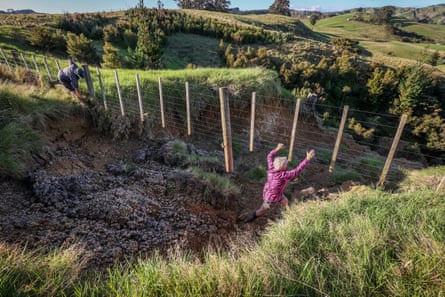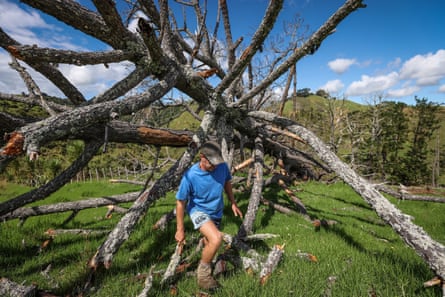Karyn Maddren walks out into the ruins of her stud farm, and stands in front of the waterfall. A month earlier, it was a green hillside. Now, the dirt has fallen away, exposing the golden-ribbed sandstone beneath. Water washes over the rocks, running clear now, carrying the last of the silt downstream.
“That particular slip has transformed into something very, very pretty,” Maddren says.
“When you’re at the bottom and you turn around you look up and there’s all the beauty. When you turn around and look the other way – there’s the ugliness.”
At her back, the farm is devastated. Huge cracks in the earth have fractured the fields where she grazes sheep. Thirty acres have simply gone; slipped away in enormous landslides, the weight of dirt carrying off trees, flax, grass, fencing.

Maddren is one of hundreds of farmers still recovering from the damage of Cyclone Gabrielle, and the multiple flooding events that preceded it. Months of unusually heavy rainfall have left the ground sodden and subsiding, the waterways clogged with debris. With the streams and culverts already full, the relentless rainfall forced the water to find new pathways, pooling and cutting its way over the farmland. For Maddren and her partner Sue Meszaros, winter – and its accompanying rainfall – are now looming.
“With the waterways clogged and rivers blocked, they don’t have to be significant events any more to cause flooding – because there’s nowhere for the water to go.”
Large chunks of New Zealand’s North Island are still devastated after the twin disasters in late January and February. Historic levels of rainfall – the largest ever recorded – inundated Auckland and the surrounding regions in January, leaving thousands of people flooded, cut off from power and water. Cyclone Gabrielle brought more flooding, landslides and enormous destruction to Hawkes Bay, Gisborne/Tairāwhiti and Northland. Many of the worst-hit regions are semi-rural and farmers are still reeling from the economic and psychological impact of the storms. New Zealand’s economy is heavily reliant on farming, and the storms are expected to have a significant ongoing effect on food prices and availability.

“It’s [had] a huge impact,” Maddren says. “Farmers are tough, tough people. Most of the time, we have to save ourselves – no one’s coming to save you, so you have to save yourself.”
“But the collective cost of this – It’s starting to take its toll,” she says. “People are feeling fragile”.
“The breadth of this storm’s impact is unprecedented, with milk collection disrupted, orchards inundated and livestock losses across much of the North Island,” Agriculture Minister Damien O’Connor said in February, announcing an initial $4m response fund. On Monday, the government announced another $26m to help farmers with cyclone cleanup.
“The broader picture among the community is that everyone’s still trying to get their heads around what damage there is,” says Maddren.

Steve Dill’s family have farmed sheep and cattle in the Kaipara hills, north of Auckland, for five generations.
“To have three massive weather events within five weeks – I just never even thought it was possible,” he says. The storms have destroyed so much fencing and farmland that he can no longer do crucial livestock control – bringing rams and ewes together to breed, or allocating and prioritising grazing land. Many of the farms that surround him are facing similar damage from enormous slips and landslides, and those on lower land have had grazing land decimated, the grass dying after weeks submerged in flood waters.
“We’ve lost like 80% of our stock control. So that’s basically destroyed our business,” Dill says. “We still can’t get to 50% of our farm, unless we walk there. It’s huge. We’re looking at a 10 year recovery.”
Some of the land has been so transformed that he does not believe it can ever be returned to agriculture.
“It’s a sort of numbing feeling,” says Dill. “You don’t really know which way to turn or look or where to even start.”

